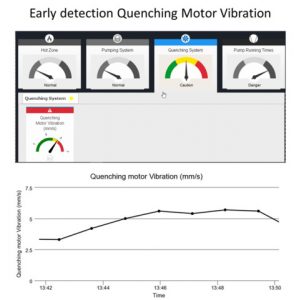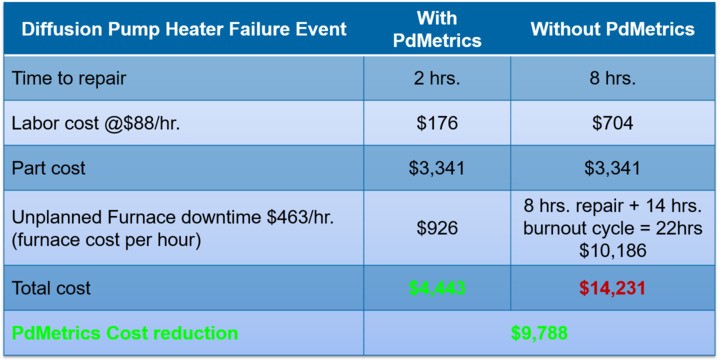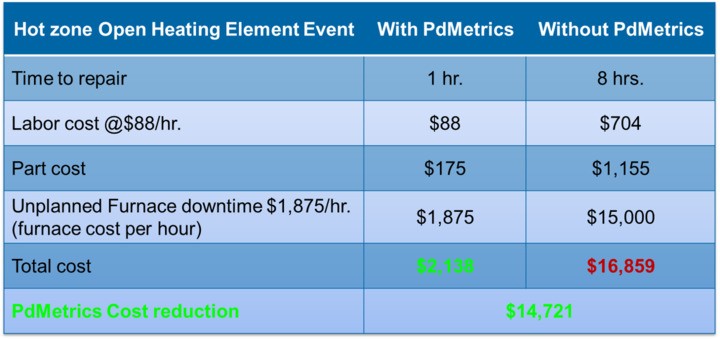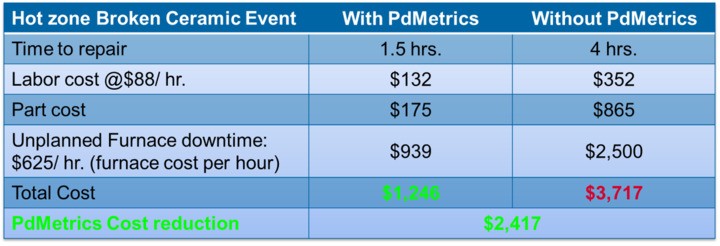5 Case Studies Prove Predictive Maintenance Software Can Save You Money
These five case studies show how Ipsen’s PdMetrics® predictive maintenance tool for vacuum and atmosphere furnaces saves maintenance technicians headaches by catching deficiencies before they become larger problems.
Case #1. Customer Finds Value in PdMetrics® for Older Furnaces
 While PdMetrics is usually installed on new furnaces to keep production running smoothly, a common misconception is that PdMetrics doesn’t belong on older equipment. One of our customers decided to invest in PdMetrics for their furnaces which were respectively 18 and 31 years old. The investment was phased in starting with the 18-year-old system first. After testing, the customer was satisfied with the software and decided to retrofit the second furnace.
While PdMetrics is usually installed on new furnaces to keep production running smoothly, a common misconception is that PdMetrics doesn’t belong on older equipment. One of our customers decided to invest in PdMetrics for their furnaces which were respectively 18 and 31 years old. The investment was phased in starting with the 18-year-old system first. After testing, the customer was satisfied with the software and decided to retrofit the second furnace.
As furnaces age, the risk and frequency of unplanned downtime increases significantly. During the same week, PdMetrics caught three major events for this customer, including an abnormal vibration issue on the quenching motor. The customer fixed these issues within a day. Early detection allowed the customer to avoid extended downtime and part quality issues. Without PdMetrics, these events are difficult to detect. In this case, PdMetrics showed a significant return on investment saving the customer about $60,000.
Case #2. PdMetrics® Identifies Which OEM’s Hot Zone is Most Efficient
PdMetrics continually monitors heat loss through the hot zone and alerts the customer when it is time to replace the insulation and/or indicates when the KW usage is higher than normal. Heat loss is measured when the customer runs a burnout cycle. The calculations are formulated once the furnace has reached a specific burnout temperature and soaked for one hour to reach steady-state heat loss.
When one customer ran a burnout cycle on their furnace, PdMetrics indicated a RED condition for heat loss of 1.14 KW/square foot. The normal PdMetrics range for heat loss is:
— Green: up to 0.75 KW/square foot
— Yellow: 0.76-0.9 KW/square foot
— Red: > 0.9 KW/square foot
In this case, the customer had replaced their Ipsen hot zone with a competitor’s hot zone. While the insulation had been replaced about two and a half years ago, PdMetrics detected rapid degradation of the hot zone, likely due to poor insulation quality and lack of thickness of the competitor’s version. In order to highlight this high heat loss value, we calculated the energy consumption to run the furnace with the existing hot zone and compared it with the original Ipsen hot zone. Below is the energy consumption calculation:
Cycle time: 5.5 hrs. (1.5 hrs. ramp, 4 hrs. at 1960°F)
Competitor Hot Zone
KW usage during the Ramp: 117 KW
KW usage at 1960°F: 422 KW-HRS
Total KW: 539 KW-HRS
Original Ipsen Hot Zone
KW usage Ramp: 45 KW-HRS
KW usage at 1960F: 240 KW-HRS
Total KW: 285 KW-HRS
With the average KW-HR cost at $0.10, the additional cost per load (using the competitor design hot zone) is $25.40. Over the course of one calendar year, with the customer running 526 loads, the additional cost is estimated at $14,400.
Case #3. PdMetrics® Mitigates Diffusion Pump Fluid Backstreaming
PdMetrics detected a low KW reading on a diffusion pump, meaning one or more of the heaters stopped functioning. As a result, the diffusion pump fluid could not reach optimum operating temperature, resulting in backstreaming into the hot zone. The customer was informed of the condition, but was unable to stop the furnace to make repairs at the time due to production requirements.
After a few weeks, PdMetrics detected the resistance to ground on the heating elements had transitioned from a GREEN condition to a YELLOW condition. A yellow condition means that the hot zone is becoming contaminated and the ceramics need to be cleaned. The customer decided to inspect the hot zone and noticed oil residue was present on the furnace cold wall as well as the bottom of the front chamber door. The customer then inspected the diffusion pump heaters to find that there were indeed issues that required intervention (what PdMetrics informed them of a week prior).

Had they acted upon the PdMetrics recommendations, they could have prevented the contamination and additional furnace downtime. Below is a general cost comparison demonstration with and without PdMetrics.
Situation #1: Furnace was running with PdMetrics; diffusion pump heater failure had been detected early on avoiding catastrophic failure
- Time to repair: 2 hrs.
- Labor cost: $176 (2 hrs. @ $88/hr.)
- Part cost: $3,341
- (2) Heaters
- (2) Crush Plates
- O-ring Kit, cold cap
- Unplanned Furnace downtime: $926 (2 hrs. @ $426/hr.)
- Total cost: $4,443
Situation #2: Furnace was not running with PdMetrics (or customer did not follow PdMetrics recommendation)
- Time to repair: 8 hrs.
- Labor cost: $176 (2 hrs. @ $88/hr.)
- Part cost: $3,341
- (2) heaters
- (2) Crush Plates
- O-ring Kit, cold cap
- Burn out cycle: 14 hrs.
- Unplanned Furnace downtime: $10,186 (22 hrs. @ $426/hr.), 8 hrs. repair + 14 hrs. burnout cycle
- Total cost: $14,231
In this instance, PdMetrics would have saved the customer $9,788.
Recently, PdMetrics detected an open heating element on a customer’s furnace, avoiding excessive hot zone repairs and contamination and furnace downtime. This furnace is implemented into a fully automated line running three shifts per day, seven days a week. The customer was able to halt production to fix the problem.
Without PdMetrics, the open heating element could have remained undetected for at least one additional shift or until the quality team discovered product issues that failed adherence to their metallurgical specifications. Such a situation could have led to full work stoppages and parts recalls. This could have meant 24 hours of lost production and combined quality assurance time invested.
The average cost of unplanned furnace downtime is estimated at $15,000 per shift or $1,875 per hour. We ran a furnace downtime cost comparison with and without PdMetrics based on this particular open heating element discovery:
Situation #1: Furnace was running with PdMetrics; open heating element had been detected early on avoiding catastrophic failure
- Time to repair: 1 hrs
- Labor cost: $88 (1 hr. @ $88/hr.)
- Part cost: $175.00 stud and washer
- Unplanned Furnace downtime: $1,875 (1 hr. @ $1,875 furnace cost/hr.)
- Total cost $2,138
Situation #2: Furnace was not running with PdMetrics; melted heating element replacement along with a contaminated hot zone
- Time to repair: 8 hrs.
- Labor cost: $704 (8 hrs. @ $88/hr.)
- Part cost: $1,155 (2) graphite heating elements, bolts and washer
- Unplanned furnace downtime: $15,000 (8 hrs. @ $1,875 furnace cost/hr.)
- Total cost: $16,859
PdMetrics saved the customer $14,721 in total parts, manpower and downtime.
Case #5: PdMetrics® Proves Successful in Detecting Potential Catastrophes
Recently, PdMetrics detected a broken ceramic on a customer’s furnace, avoiding potential temperature uniformity issues within the hot zone. This customer placed a value of $5,000 per shift based on furnace utilization at 100%. Based on the above customer-supplied information, the below cost study was generated.
Situation #1: Furnace was running with PdMetrics; the broken ceramic had been detected early on, avoiding catastrophic failure
- Time to repair: 1.5 hrs.
- Labor cost: $132 (1.5 hrs. @ $88/hr.)
- Part cost: $175
- Unplanned Furnace downtime: $939 ($625 furnace cost/hr.)
- Total cost $1,246
Situation #2: Furnace was not running with PdMetrics, necessitating a complete element hanger replacement, melted heating element, burned retaining plenum pin along with adjacent shielding damage
- Time to repair: 4 hrs.
- Labor cost: $352
- Complete element hanger replacement: $176 (2 hrs @ $88/hr.)
- Heating element replacement: $88 (1hr @ 88/hr.)
- Cleaning adjacent shielding: $88 (1hr @ 88/hr.)
- Part cost: $865
- Element Hanger: $375
- Heating element: $490
- Unplanned furnace downtime: $2,500 (4 hrs. @ $625 furnace cost/hr.)
- Total cost: $3,717
In this particular event, PdMetrics saved the customer an estimated $2,471 through decreased downtime. Such events can happen several times during the year.
Note: Situation #2 is based on a best-case scenario, assuming the customer has parts on hand and maintenance team availability.




